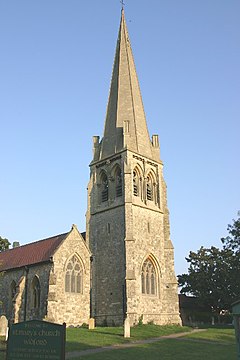Widford, Essex
| Widford | |
|---|---|
 St. Mary's Church, Widford |
|
| Widford shown within Essex | |
| District | |
| Shire county | |
| Region | |
| Country | England |
| Sovereign state | United Kingdom |
| Police | Essex |
| Fire | Essex |
| Ambulance | East of England |
| EU Parliament | East of England |
Widford is a parish of Chelmsford approximately 1.5 miles (2.4 km) south-south-west of the city’s railway station. The current parish boundary encloses a mixed residential, industrial and rural area south of the River Can, east of the River Wid and mostly to the west of the Great Eastern Main Line.
Widford is first recorded in 1216 (as Witford); the later 13th century forms Wydiford and Wydeford show that derivation from "withig" (by the willows) is probable. The name of the River Wid is a later back formation.
In early times the area was inhabited by the Iceni and later by the East Saxons. In 1329, the manor of Widford was held by , Earl of Kent; and it afterwards passed to the Mortimer, Bacon, Altham, and other families.
White’s Directory of Essex, published in 1848, describes Widford as ‘a small parish on the London road’ (the old Roman road which has become the A414, Widford Road & Moulsham Street). It contained 692 acres (280 ha) of land, and about 190 inhabitants. When the census was taken in July 1841, its population had been swelled by railway labourers to 362. Widford village had about 300 occupants, but appeared to have been split so that some of it was in Chelmsford parish.
John Attwood MP owned most of the land and lord of the manor. The description from 1848 goes on to say that he ‘has a handsome seat here, called Hylands on the western acclivity of the valley, commanding extensive views. Though the house was large and handsome, he is now erecting a more elegant and spacious mansion. The park and pleasure grounds are extensive and beautiful. The old house was erected by Chief Justice John Comyns, Kt, in about 1730, and was much improved by the late P. C. Labouchere, Esq. Mr. Attwood is one of the parliamentary representatives of Harwich.’
The description of the village goes on ‘the Church (St. Mary) is a small neat structure of mixed architecture, but evidently of Saxon origin. The wooden turret, at the west end, has two bells, and is crowned by a small spire. There is a chapel belonging to the lord of the manor, and near it is a monument in memory of Viscountess Falkland. The rectory, valued in K.B. at £8, and in 1831, at £225, is in the patronage of J Attwood and incumbency of the Rev William Buswell BA, who has a good residence, which he has lately much improved. The tithes were commuted in 1838, for £257 per annum. Mr. Attwood built a Schoolhouse in the church yard in 1843. In 1776, Lady Falkland left £200 to this parish, to provide for a weekly contribution of bread among the pool attending the church. To increase this charity, the Rev John Saunders left £100 in 1814. These bequests now form a fund of £379.4s.9d. three per cent Consols, and the dividends are applied in a weekly distribution of 17 threepenny loaves. In 1738, Benjamin Sarjant left £100 three per cent. Reduced Annuities, in trust, to apply the dividends yearly in clothing, for two poor widows, and two poor widowers.’
...
Wikipedia

